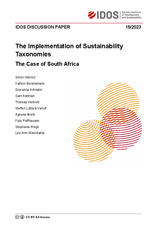The implementation of sustainability taxonomies: the case of South Africa
Hilbrich, Sören / Kathrin Berensmann / Giovanna Artmann / Sam Ashman / Theresa Herbold / Steffen Lötters-Viehof / Agnese Monti / Felix Paffhausen Stephanie Roigk / Lee-Ann SteenkampDiscussion Paper (15/2023)
Bonn: German Institute of Development and Sustainability (IDOS)
ISBN: 978-3-96021-218-8
DOI: https://doi.org/10.23661/idp15.2023
Price: 6 €
see also:
The implementation of sustainable finance taxonomies: learning from South African experiences
(Policy Brief 20/2023)
In recent years, many jurisdictions have developed sustainability taxonomies that aim to increase transparency of financial markets and redirect capital flows to sustainable investments. Such sustainable finance policies can be important levers because today’s investments shape economic production processes for decades. This case study on South Africa’s Green Finance Taxonomy (GFT) addresses the question of what factors influence the adoption of sustainability taxonomies by potential users. It finds that one year after its publication, the GFT has hardly been used in practice. Important factors hindering an effective implementation are a lack of regulatory embedding, the absence of a legal recognition of the GFT by the European Union (EU), a hesitancy among financial market participants to build capacities to collect the necessary data, and fossil-fuel path dependencies in South Africa’s economy. These findings have important policy implications (e.g. regarding accompanying governance measures) for implementation processes in many countries in the coming years.



